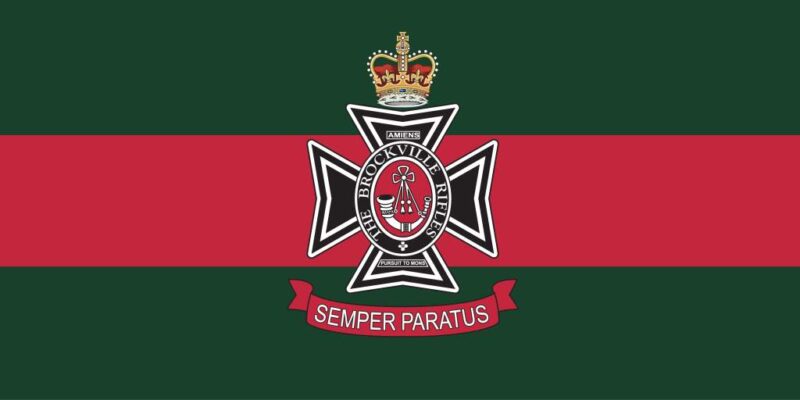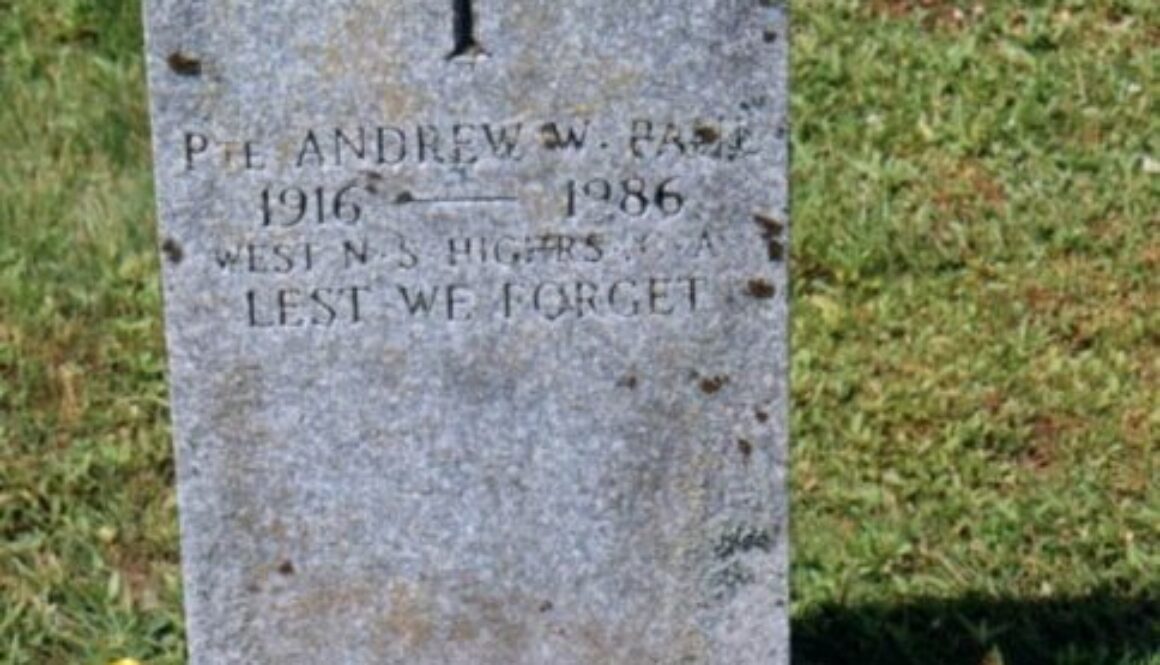Pte. Andrew W. Paul (1916 – 1986)
Andrew Wilfred (Andy) Paul had known life only on the Millbrook. N.S., Mi’kmaq First Nations Reserve – up to the midpoint of the Second World War.

And in early 1943, 27-year-old Andy Paul was one of a group of men from the reserve, that straddles the old Trans-Canada Highway in scenic, wooded Colchester County in central Nova Scotia, who made their way to Halifax to join the Canadian Army. When he signed up he would be making $1.50 a day.
Copies of his wartime army documents from the Canadian Forces Records Centre in Ottawa were retrieved to verify his service to the Last Post Fund which erected his headstone on the Sacred Heart Cemetery of the Millbrook Reserve in 1987.
The 14 documents, a mixture of typewritten forms with various official stamps and fountain-pen and pencil entries, showed he enrolled in Halifax in early 1943 and received an honourable, medical discharge at No. 6 District Depot, Halifax, in late 1944 and returned to civilian life. He was five feet nine inches, of slender build, 135 pounds, upright, dark-complexioned, dark hair and dark brown eyes, according to his military documents, and medically fit for military service, according to some unknown MD. He reported Grade 8 education and that his language of preference was Mi’kmaq and English, likely in that order.
On enrollment, he stated he was married to Irene (Cope) Paul, of Millbrook, supported daughters Cecilia, Marie, Phyllis and Evelyn, and that his civilian occupation was carpenter apprentice.
His trade on enrollment was infantryman, in the rank of private, and he was taken on strength with the North Nova Scotia Highlanders for basic training. There are some typewritten entries about his progression and courses of instruction and a notation that he was an average, quiet soldier.
“Being from a reservation and barely able to speak English . . . it was a sudden integration. It was a shock. I was stunned for two or three months while taking basic training.” — Peter Whitecloud, Second World War veteran. (From Native Soldiers / Foreign Battlefields. Government of Canada / Veterans Affairs Canada. 1993)
Pte. Paul continued his army service in Aldershot, N.S., and later sent by troop train to Kingston, Ont., where he was taken on strength by The Brockville Rifles, until he was returned to his original regiment not long before they, and The Brockville Rifles, were scheduled to go overseas to form part of the invasion force named Operation Overlord.
The documents are unclear why Pte. Paul did not go overseas but he was honourably discharged in late 1944 in Halifax and returned to civilian life about 60 miles away. Andy, as he was commonly known, reintegrated into life on the Millbrook reserve and worked for many years as a carpenter, bricklayer, taxi driver and Band Councillor.
His file showed he neither applied for, nor received, any financial assistance from Veterans Affairs Canada at any time and he and his wife, Irene, who predeceased him in 1965, continued to raise their four daughters in their small home on Willow Street.
Andrew was known to participate each year in Remembrance Day services on the Millbrook Reserve and in downtown Truro and was proud to wear his three medals just below his poppy. And when he died of heart failure at the QE II Health Sciences Centre in 1986, a colour party from Royal Canadian Legion Branch 26, Truro, was present at his funeral as a tribute to his life and service to Canada as a proud aboriginal veteran, a man who chose out of necessity to speak his native tongue in a primarily English-speaking milieu that was the wartime Canadian army.
His second-eldest daughter, Marie, was married to Mr. Peter Magwood in 1987. Marie told some anecdotes about her late father, including his employment as a taxi driver on the Millbrook Reserve and his habit of driving a “big mobile” very slowly along Willow Street with a long, impatient procession of other vehicles following behind on two-lane Highway 2. He would sometimes come to a complete stop before making a left or right turn, she said, adding, with a smile, that her father sometimes commented that motorists were testing their automobile horns behind him for some unknown reason and even waving at him.
Driving habits notwithstanding, he was an accomplished bricklayer and erected and repaired many chimneys in houses on the Millbrook Reserve, wood being a primary heat source, for only dollars a day.
I met him only once, and found him a reserved, wiry man, with a pervasive look in his dark eyes that had seen native life in rural Nova Scotia during the First World War, on and up to his death in 1986.
“We used to eat grass, you know,” he told me.
We shook hands and I was proud and privileged to have met him. I told him I had served in the navy and the naval reserve (I did not give my rank, PO2). And his reply was a shrug and a thin smile with a typical pursing of the lips followed by a look into the distance I had often seen in my wife when she wanted to point something out or was thinking.
When Marie passed away from cancer on Sunday, Feb. 19, 2012, Sacred Heart Roman Catholic Church made sure her ashes would be interred close to her beloved father’s remains, in a sunny area of the church cemetery that fronts onto a scenic, deep woods in the southern reaches of the reserve, which has about 800 inhabitants.
In the early 1990s the Millbrook Band commissioned and had erected a fine war memorial in the central part of the reserve on Willow Street. It is engraved with dozens of names of band members who served in the Army, Navy and Air Force in the two world wars, the Korean conflict and armed missions in following years. Pte. Andrew W. Paul’s name has pride of place among the Second World War men.
Andy’s second-youngest daughter, Phyllis, is buried beside Marie. And when I go and pay my respects each year to Marie, I make it a point to pause and say a few words of thankful remembrance to Marie, Andy, Phyllis and the other war veterans — with their identical markers – silent, grey sentinels in the small, tidy cemetery with its white arch and open, clean air with the quiet, sacred woods just beyond.
The booklet Native Soldiers / Foreign Battlefields says more than 7,000 Indians served in the First and Second world wars and Korean conflict.
“On each occasion, Canada’s Native soldiers overcame cultural challenges and made impressive sacrifices and contributions to help the nation in its efforts to restore world peace.
It was an incredible response – consistent with a remarkable tradition.”
Submitted by Mr. Peter Magwood


